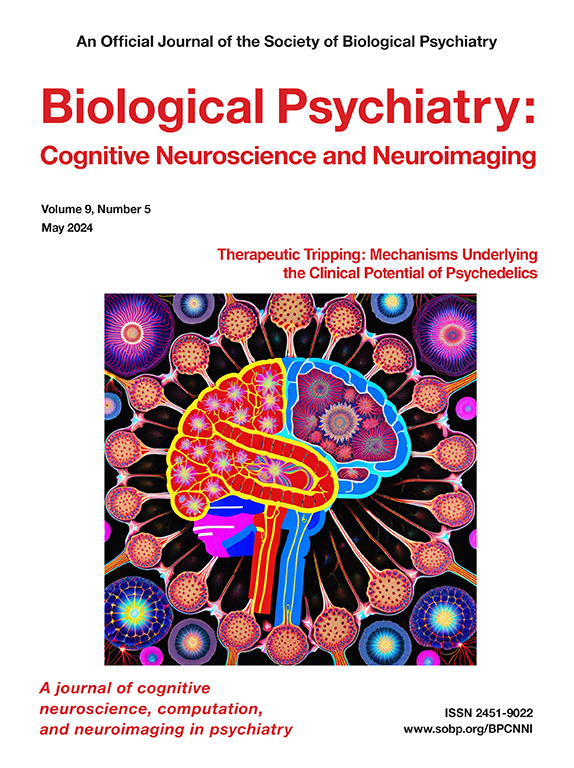Penetrance of Neurodevelopmental Copy Number Variants Is Associated With Variations in Cortical Morphology
IF 4.8
2区 医学
Q1 NEUROSCIENCES
Biological Psychiatry-Cognitive Neuroscience and Neuroimaging
Pub Date : 2025-10-01
DOI:10.1016/j.bpsc.2025.05.010
引用次数: 0
Abstract
Background
Copy number variants (CNVs) may increase the risk for neurodevelopmental conditions. The neurobiological mechanisms that link these high-risk genetic variants to clinical phenotypes are largely unknown. An important question is whether brain abnormalities in individuals who carry CNVs are associated with their degree of penetrance.
Methods
We investigated whether increased CNV penetrance for schizophrenia and other developmental disorders was associated with variations in cortical and subcortical morphology. We pooled T1-weighted brain magnetic resonance imaging and genetic data from 22 cohorts from the ENIGMA (Enhancing Neuro Imaging Genetics through Meta Analysis)-CNV consortium. In the main analyses, we included 9268 individuals (aged 7–90 years, 54% female), from which we identified 398 carriers of 36 neurodevelopmental CNVs at 20 distinct loci. A secondary analysis was performed including additional neuroimaging data from the ENIGMA-22q consortium, including 274 carriers of the 22q11.2 deletion and 291 noncarriers. CNV penetrance was estimated through penetrance scores that were previously generated from large cohorts of patients and controls. These scores represent the probability risk of developing either schizophrenia or other developmental disorders (including developmental delay, autism spectrum disorder, and congenital malformations).
Results
For both schizophrenia and developmental disorders, increased penetrance scores were associated with lower surface area in the cerebral cortex and lower intracranial volume. For both conditions, associations between CNV-penetrance scores and cortical surface area were strongest in regions of the occipital lobes, specifically in the cuneus and lingual gyrus.
Conclusions
Our findings link global and regional cortical morphometric features with CNV penetrance, providing new insights into neurobiological mechanisms of genetic risk for schizophrenia and other developmental disorders.
神经发育拷贝数变异的外显率与皮层形态的变异有关。
背景:拷贝数变异(CNVs)增加神经发育疾病的风险。将这些高风险遗传变异与临床表型联系起来的神经生物学机制在很大程度上是未知的。一个重要的问题是,携带CNVs的个体的大脑异常是否与他们的外显率有关。方法:我们研究了精神分裂症和其他发育障碍的cnv外显率增加是否与皮质和皮质下形态的变化有关。我们汇集了来自ENIGMA-CNV联盟的22个队列的t1加权脑磁共振成像和遗传数据。在主要分析中,我们纳入了9268名个体(年龄在7岁至90岁之间,其中54%为女性),从中我们在20个不同的位点鉴定出398名36个神经发育CNVs携带者。对来自ENIGMA-22q联盟的额外神经影像学数据进行二次分析,包括274名22q11.2缺失的携带者和291名非携带者。cnv外显率是通过外显率评分来估计的,外显率评分是以前从大量患者和对照组中产生的。这些分数代表了患精神分裂症或其他发育障碍(包括发育迟缓、自闭症谱系障碍和先天性畸形)的概率风险。结果:对于精神分裂症和发育障碍,外显率分数的增加与大脑皮层表面积和颅内容积的降低有关。在这两种情况下,cnv外显率评分和皮质表面积之间的关联在枕叶区域最强,特别是在楔叶和舌回。结论:我们的研究结果将整体和区域皮质形态特征与cnv外显率联系起来,为精神分裂症和其他发育障碍的遗传风险的神经生物学机制提供了新的见解。
本文章由计算机程序翻译,如有差异,请以英文原文为准。
求助全文
约1分钟内获得全文
求助全文
来源期刊

Biological Psychiatry-Cognitive Neuroscience and Neuroimaging
Neuroscience-Biological Psychiatry
CiteScore
10.40
自引率
1.70%
发文量
247
审稿时长
30 days
期刊介绍:
Biological Psychiatry: Cognitive Neuroscience and Neuroimaging is an official journal of the Society for Biological Psychiatry, whose purpose is to promote excellence in scientific research and education in fields that investigate the nature, causes, mechanisms, and treatments of disorders of thought, emotion, or behavior. In accord with this mission, this peer-reviewed, rapid-publication, international journal focuses on studies using the tools and constructs of cognitive neuroscience, including the full range of non-invasive neuroimaging and human extra- and intracranial physiological recording methodologies. It publishes both basic and clinical studies, including those that incorporate genetic data, pharmacological challenges, and computational modeling approaches. The journal publishes novel results of original research which represent an important new lead or significant impact on the field. Reviews and commentaries that focus on topics of current research and interest are also encouraged.
 求助内容:
求助内容: 应助结果提醒方式:
应助结果提醒方式:


